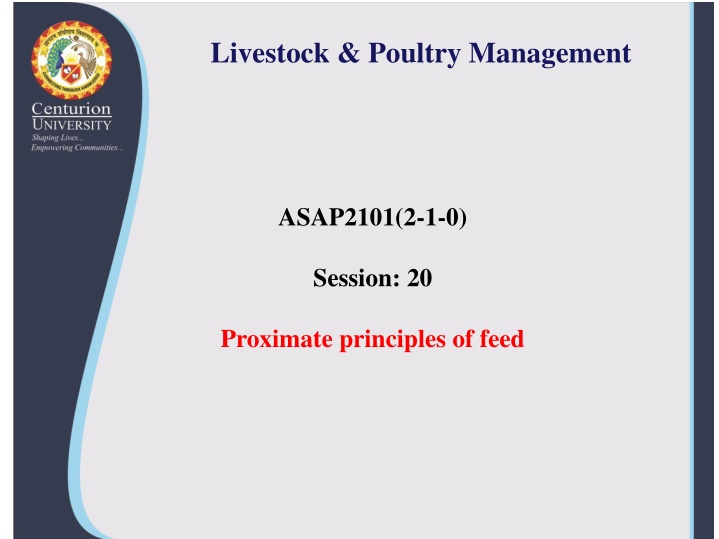
Proximate Principles of Livestock Feed Management
"Explore the proximate principles of livestock feed management, including water, crude protein, crude fat, crude fiber, NFE, and ash content. Understand the significance of moisture, demerits of improper drying, and the estimation of crude protein. Discover the assumptions underlying Kjeldahl analysis in livestock and poultry management."
Download Presentation

Please find below an Image/Link to download the presentation.
The content on the website is provided AS IS for your information and personal use only. It may not be sold, licensed, or shared on other websites without obtaining consent from the author. If you encounter any issues during the download, it is possible that the publisher has removed the file from their server.
You are allowed to download the files provided on this website for personal or commercial use, subject to the condition that they are used lawfully. All files are the property of their respective owners.
The content on the website is provided AS IS for your information and personal use only. It may not be sold, licensed, or shared on other websites without obtaining consent from the author.
E N D
Presentation Transcript
Livestock & Poultry Management ASAP2101(2-1-0) Session: 20 Proximate principles of feed
Overview 1. Introduction 2. Proximate Principles 3. Demerits of Proximateanalysis 4. Merits of Proximateanalysis 5. Conclusion
Proximate principle 1.Water (moisture) 2.Crude protein 3.Crude fat (ether extract) 4.Crude fiber 5.NFE (Nitrogen free extract) 6.Ash
Water (Moisture) Principle It isdetermined by drying feed sample in hot oven at 100 0C for a specified length of time DM,% = wt after drying/wt before drying x 100% air % Moisture = 100 DM,%
Significance of moisture Moisture determines the keeping quality of hay Moisture content determines the losses in silage making Usefull in classification of feed in to succulent and non-succulent Moisture content is significant in storage of feed Moisture content is important while purchasing of feed Moisture content is directly related to nutritive value of feed
Demerits Drying above 60oC can create artifacts that hinder lignin, fiber & ADFanalysis Most likely underestimate dry matter Loss of volatile fatty acids (VFA's)
Crude protein Estimated indirectly by determining the nitrogen content of feed and multiplying it with 6.25. Estimated by a process developed by a Danish chemist Johan Kjeldahl. 100/16 = 6.25, therefore: NITROGEN x 6.25 = CRUDE PROTEIN Principle andScope In the presence of sulfuric acid, sodium sulphate and a catalyst, the amino nitrogen of many organic materials is converted to ammonium sulphate. The ammonia is distilled from an alkaline medium and absorbed in standardized mineral acid.
Assumptions of Kjeldahl analysis 1.All proteins contain 16% constant 6.25 to convert N to protein. N. Hence uses 2.All N in the food comes from true protein.
Problems with assumption 1 All amino acidsare not createdequal AminoAcid Alanine Arginine Aspartate Cystine Glutamate Therefore, all proteinsare not createdequal Protein Casein Glycinin Hemoglobin Ovalbumin Serumglobulin 16.2 %Nitrogen 15.72 32.16 10.52 11.66 9.52 %Nitrogen 15.9 17.5 16.8 15.5 (Kaiser et al.,1995) (Kaiser et al.,1995)
Problems with assumption 2 True protein in the plant is overestimated by Crude Protein value (Maynard and Loosli,1979). the The use of concentrated sulfuric acid at high temperatures poses a considerable hazard The technique is time consuming to carry-out
Crude Fiber Principle Two boiling processes simulate the pH conditions of the digestivetract Crude fiber composed hemicelluloses, and lignin Lignin is not a true carbohydrate The method has been widely used to determine the fiber content of feed but it has some serious shortcomings of cellulose,
Demerits C.F. - Indigestible and nonnutritive residue Acid and base solubilize some of hemicelluloses, pectin and lignin NFE overestimated of a feed therefore tends to be Hence crude fiber underestimates true fiber
Crude fat Principle and Scope A dried, ground sample is extracted with diethyl ether which dissolves fats, oils, pigments and other fat solublesubstances. Demerit This process assumes all substances soluble in ether are fats. Plant pigments, wax which are also soluble in ether, but do not have the same nutritional values offats
Nitrogen free extract (NFE) Principle NFE represents the soluble carbohydrate of the feed, such as starch and sugar. % NFE = % DM - (% EE + % CP + % ash + % CF) Demerit NFE not determined analytically but is calculated by difference. Therefore, NFE accumulates all of the errors that exists in other proximate analysis components.
TotalAsh Principle When a sample is burnt in muffle furnace at 600oC for 2 hours, only mineral matter is left behind. This isthe total ash or mineral content of feed. %Ash =wt. afterashing/sample wt. x 100% Demerits No indication of amounts of individual minerals. Long time required(12-24hours). Muffle Furnaces are quite costly to run Loss of volatile minerals e.g., Cu, Fe, Pb, Hg, Ni, Zn.
Advantages of ProximateAnalysis Comparison of feeds on a specific basis It is a common basis for the feed purchasing and for ration formulation No substitute till today except for fiber component It forms Starting point for specific analysis Used for analysis of feeds, faeces, urine, body tissues, bodyfluids
Conclusion Proximate approximating the nutritive value of feedstuff without actually using it in feeding trial It is simple and yet descriptive method for evaluating the nutritive value of feeds analysis is a system for Main underestimates dry matter, assumes that all proteins contain 16% N, considered as in indigestible non residue, this process assumes all substances soluble in ether fats, it does not includes demerits of this system are it crude fiber is nutritive
